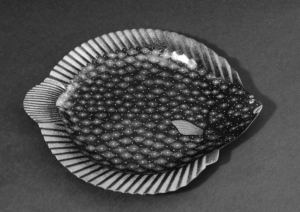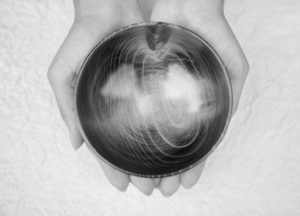Panel Discussion

Comments on the Jurors’ Special Prize Winners(4/4)

乾漆皿「華麗」
Dry-Lacquer Plate “Glorious (Karei)”
W29.5 × D26 × H2
2016
山崎 夢舟
YAMAZAKI, Mushu (Japan)
Shinya YAMAMURA ───── Coincidently, ‘Dry–Lacquer Plate “Glorious (Karei)”’ is created by Mushu YAMAZAKI from Yamanaka, where the recipient of the Honorable Mention, Mr. OSHITA also comes from. I commented on Mr. OSHITA’s work and I know Mushu well. He is an expert Urushi artist and his works have been widely distributed overseas. I mentioned that one of the important things as a creator is that the products are handed to the users. One more important thing is that the items endure by being passed on from one generation to the next.
So, what kind of items endure? One condition is that the work reflects the artist’s strong passion. Second, that the artist has excellent techniques. Third, the amount of time the artist spends creating the work. Such conditions can be understood by connoisseurs. Works which meet these conditions are treasured and will remain for a long time. Such works will remain in various ways; as a personal treasure an individual cannot bear to part with, or as part of a museum collection. This aspect is very important, and from this perspective, I have judged the submitted works for the exhibition.
Among all the excellent works, I was sure that Mushu’s work will certainly remain for a long time, and so I selected this work for my Special Prize. Personally, I still feel that this work is good enough to be awarded one of the higher prizes.
OHNISHI ───── Next, comment on the Masahito SHIHO prize, please.

mebuki椀〈金〉
Mebukiwan Gold
W10.9 × D10.9 × H5.3
2018
株式会社 匠頭漆工
Shozu Shikko Inc. (Japan)
SHIHO ───── This is also a work created in Yamanaka by Shozu Shikko, ‘Mebukiwan Gold.’ I’m afraid that you will have difficulty in imagining the real work from only the images. By applying decoration to the gaps from knots in the wood, they can make use of the wooden base, which was rejected as a market product. The part which looks a little like a snail is where the decoration has been applied to the knot in a similar way to the Kintsugi technique (the repair of ceramics with gold–dust lacquer). By doing so, they add another value to the product. So, my Special Prize for the work is like a company design department product development prize.
As you know, the Yamanaka Urushi ware production area is famous for woodturning. When you use a natural material like wood, the material will have imperfections such as knots. Knots are difficult for woodworkers as the tools might chip, the wood is difficult to cut, and the knots cause coatings to crack. From a safety point of view, the material would have been rejected. However, by reversing the idea that the knots are a disadvantage, they decided to treat the knots systematically. The woodworkers carve the wood, the Urushi coating artisans apply a polishing powder for a Medome filling and then finish the surface with Fuki Urushi. Finally, Makie artisans decorate the knotted parts with the technique of Kintsugi.
Originally, as wooden bases for Yamanaka Urushi ware, they have often used zelkova, Japanese cherry birch called Hansa, and Japanese horse chestnut. They have also used Japanese cypress with knots. They have made the best use of these bothersome knots by interpreting them as the parts from where a new shoot emerges. So they emphasize this auspicious interpretation and recommend them as suitable gifts for birthdays as well as other important life events. This time the maker submitted an 11cm diameter soup bowl for children. At the exhibition, ten pieces of this soup bowl will be exhibited.
